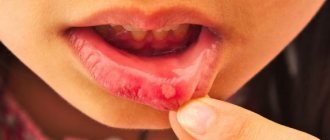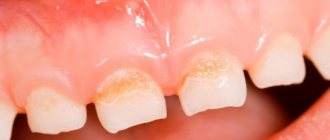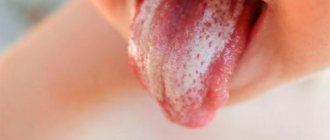07/05/2021 Reading time: 3.5 min 8092 0
Thrush in children is an infectious disease. The causative agent is a fungus of the genus Candida. Therefore, it has the medical name “candidiasis”. Not only the oral mucosa can be affected, but also the skin and membranes of internal organs.
Yeast-like fungi are natural inhabitants of our body. There are many reasons for activating their growth:
- early childhood
- imbalance of microorganisms
- nutritional pattern
- taking antibiotics
- long-term inhaled hormone therapy
About the disease
Thrush is one of the most common diseases that occurs against the background of increased activity of fungi of the genus Candida.
The disease got its name because of the characteristic white (“milky”) coating that forms on the affected mucous membranes. The pathogen is normally present in small quantities on the surface of the oral cavity, skin, and objects of daily use. However, this concentration of fungi, provided the immune system is functioning normally, is not enough to cause any clinical manifestations of pathology.
Newborns and infants are automatically at risk of developing the disease. This is due to the immaturity of the immune system and the minimum number of natural barriers to the penetration of fungi into the baby’s body. Therefore, thrush is a relatively common problem that many parents may encounter. In 90% of cases there is no need to be afraid of the disease, but you also cannot ignore the symptoms due to the risk of developing complications.
Thrush in infants
Treatment of thrush in infants depends on the extent of the pathological process. In the early stages, with local damage, local therapy is indicated - irrigation of the oral cavity with anti-candidiasis (clotrimazole, nystatin), alkalizing (2% baking soda solution, 0.25% boric solution) and disinfectants (aniline dyes - Lugol's solution, methylene blue) agents. When breastfeeding, treatment of the mother's breast with a 2% soda solution and herbal infusions (oak, calendula and others) is indicated. Such treatment is carried out until the child recovers completely, but for a period of at least 14 days.
For moderate and severe forms, systemic therapy through oral or parenteral administration of antifungal drugs is recommended. When using anticandidal drugs orally, preference is given to powders for injection (fluconazole), since the prepared solution has not only a general, but also a local effect on the mucous membranes of the oral cavity. In parallel, treatment of concomitant diseases and symptomatic therapy according to indications is carried out in full. According to modern recommendations, this approach should also be used for mild forms, since it allows reducing the treatment time to 3-6 days.
Forecast and prevention of thrush in infants
The prognosis for thrush in infants is favorable. With timely, rational therapy, complete recovery occurs within 7-10 days. Severe forms and the development of complications are observed only in the absence of antifungal treatment. Nonspecific prevention of candidal stomatitis consists of proper care of the child’s skin and mucous membranes, especially against the background of severe pathologies that reduce immunity. An important role is given to the rational use of antibacterial agents and the treatment of fungal diseases in the mother during the period of bearing a child.
Specific prevention of thrush in infants is necessary if there are indications, which include a complicated obstetric and gynecological history of the mother, prematurity and intrauterine malformations of the child, respiratory disorders, birth injuries of newborns, and pathologies of the central nervous system. Newborns included in this group undergo microscopy and bacteriology of samples of mucous membranes and feces during the first 7 days of life. For infants on antibacterial therapy, a prophylactic course of an antifungal drug, usually fluconazole, is prescribed.
Symptoms of thrush
The pathogenetic basis of the disease is the occurrence of a local inflammatory process at the site of fungal invasion.
They begin to actively reproduce with the release of waste products, which provokes an appropriate immune response from the child’s body. The clinical picture of thrush is characterized by the formation of a typical white plaque in the affected area. In the early stages of the disease, it is not always possible to immediately distinguish colonies of fungi from remains of food or milk. Parents sometimes ignore the problem, especially in the absence of other signs of the disease. To differentiate, it is enough to wipe the baby’s tongue or lips with a napkin or damp towel. Residues of food can be easily washed off. But fungal colonies are difficult to grow, so they remain. Common additional clinical symptoms:
- irritability of the child, frequent crying;
- deterioration of appetite up to complete refusal to eat. It all depends on the degree of damage to the oral mucosa by the fungus;
- disruption of normal sleep rhythm.
In advanced cases, when the fungus spreads to the underlying parts of the digestive tract - into the lumen of the esophagus, stomach and intestines, dyspeptic disorders (abdominal pain, nausea, regurgitation, diarrhea-type bowel dysfunction) are additionally associated. In case of damage to the external genitalia, a characteristic white coating is found in the area of the labia majora and minora (in girls) or the foreskin (in boys).
Stages of the disease
The disease begins at a mild stage, when reddish spots are barely visible on the mucous membrane, soon giving way to a cheesy white coating. At this stage, the child does not feel much discomfort, and the infection itself is easily treatable. If treatment is not carried out, then thrush enters the middle stage, when spots and plaque merge and form islands that fill almost the entire oral cavity. At this stage, when trying to clean the plaque, bleeding ulcers appear. The child becomes restless, especially during sucking. In the severe stage of thrush, bleeding increases and quite intense pain appears. Fever often develops and bowel movements are disrupted. It is advisable to treat this form of thrush in a hospital setting.
According to the course of the disease, acute and chronic forms are distinguished. The acute form is more common, and the chronic form is usually a companion to other diseases. In the acute form, the plaque is white, cheesy, with a tendency to expand the affected areas up to the corners of the mouth. In addition to discomfort, the child may experience increased temperature, enlarged and painful lymph nodes (usually submandibular). For diagnosis, the doctor will take a scraping of the plaque and, upon examination, will find in it epithelial cells, food debris, fibrin fibers and, of course, the pathogen itself.
In the chronic form, the coating is yellowish or brown and more dense. Touching the affected mucous membrane causes severe pain. There is swelling around the lesion, and nearby lymph nodes are also enlarged. As with the acute form, the child’s behavior changes - older children complain of pain when eating, and infants become whiny and restless. This form is difficult to treat, so it is important to prevent acute thrush from becoming chronic.
Complications from thrush are usually associated with disruption of the digestive tract and respiratory system, however, there is a risk of developing diseases of other organs. If adequate treatment is not carried out in time, thrush can develop into a chronic, recurrent form.
Causes of thrush
The cause of the development of thrush is the proliferation of a fungus of the genus Candida. The key condition for the activation of this microorganism remains a decrease in the body’s immune defense. The weakening of protective mechanisms, in addition to the immaturity of the immune system, can be provoked by the following factors:
- Inadequate child care. If basic hygiene rules are ignored, the amount of fungus that gets on the baby’s mucous membranes increases. This creates an additional burden on the immune system of the infant or newborn.
- Abuse of sweets. Candida is a fungus that successfully uses glucose to reproduce. Against the background of impaired immune system function, frequent eating of sweets increases the chance of getting sick.
- Congenital or acquired immunodeficiency. Seasonal viral infections and exacerbations of chronic somatic diseases increase the risk of thrush.
- Decreased protective function of saliva. With dental diseases, there may be a decrease in the performance of the salivary glands, which also contributes to changes in the microflora of the oral cavity.
Infection with fungi can occur from the mother during pregnancy, when using contaminated dishes or personal hygiene items. Therefore, it is extremely important in early childhood to boil pacifiers, jars, and wash hands before contact with the child.
Causes of thrush
What are the causes of this disease? Often, a child becomes infected from the mother during childbirth, or if the mother neglects intimate hygiene. Therefore, a pregnant woman diagnosed with bacterial candidiasis needs to be observed by specialists. Infection through toys and pacifiers is possible in the absence of sanitary treatment. Thrush can occur in children while taking antibiotics, allergies, a tendency to regurgitate, or frequent colds. These facts indicate that the pathogenic fungus lives in almost every person, but becomes pathogenic only with a decrease in immunity and in the presence of a suitable environment (lactic acid).
Mothers need to know that a baby who receives breast milk is less likely to encounter thrush problems. But, nevertheless, an important factor in protecting against infection is the observance of simple hygiene rules, this becomes especially important as the baby grows up, when all objects that fall into his hands immediately end up in his mouth.
Diagnosis of thrush
“SM-Doctor” is a multidisciplinary medical center specializing in the identification and treatment of all types of diseases in children from 0 to 18 years old.
Thanks to modern equipment and experienced staff, our clinic provides patients with a full range of diagnostic services. This ensures quick and high-quality detection of thrush. The doctor can diagnose fungal infection of the mucous membranes during the initial examination of the child. After collecting anamnesis and analyzing the patient’s complaints, the doctor assesses the condition of the affected area of the body. If a characteristic plaque is detected in combination with the above symptoms, a preliminary diagnosis is made. To confirm it, the following additional procedures are used:
- microscopic analysis of scrapings from the affected area of the mucous membranes;
- traditional laboratory tests - general and biochemical analysis of blood and urine.
If there is a suspicion of concomitant somatic pathology, the doctor may refer the child for consultation to related specialists. Sometimes weakened immunity can be a consequence of gastritis, cholecystitis or other diseases of the internal organs.
Treatment of thrush
Thrush in children is a common problem that at first glance does not pose a threat to life, but if left untreated, the disease can progress and affect new areas of the body.
This can manifest itself as persistent dysfunction of digestion, fusion of the labia in girls, and the formation of zones of chronic inflammation. Drug therapy for thrush includes the use of the following drugs:
- Probiotics are a group of drugs used to restore the normal microflora of affected mucous membranes. The goal is to strengthen local immunity so that the body can independently eliminate fungal colonies.
- Local antiseptics (soda, iodine, methylene blue). The goal is to destroy the fungus.
- Antifungal agents. These drugs are used when nonspecific drugs are ineffective.
For newborns and infants, in addition to prescribing the above remedies, doctors recommend carefully following the rules of child care, humidifying the air, and providing the baby with adequate nutrition. In most cases, with adequate therapy, it is possible to completely eliminate the symptoms of thrush within 7-10 days.
How to treat thrush in a child?
The disease is treated at home. Local medications are used and only as prescribed by a doctor: pediatrician or dentist! Special antifungal agents are used in the form of solutions, sprays, gels, and drops. For maximum effectiveness of therapy, the drug must remain in the oral cavity (on the mucous membrane) for as long as possible. Therefore, the main way to use them is by rinsing or lubricating.
Treatment is long, up to 2-3 weeks.
It is important!
Often thrush in the mouth of infants is associated with candidiasis of the skin of the nipples and areola in the mother. In this case, the woman experiences redness, irritation, and a burning sensation on her chest. In this case, treatment should be comprehensive, for mother and baby.










